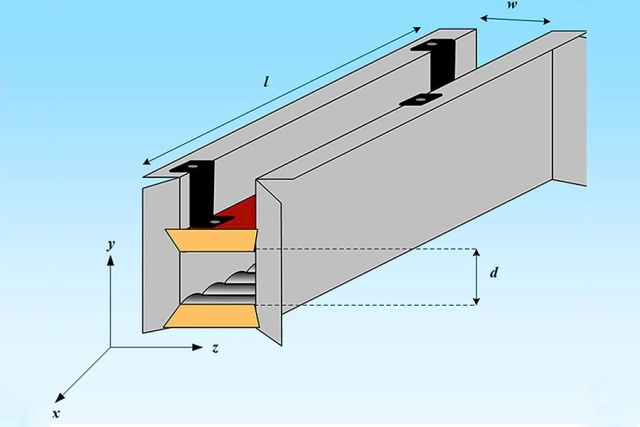May 27 2016
Visualize an instrument that is transparent to different wavelengths of light for an instant and turns opaque the next, after a small alteration.
 An illustration shows the experimental set-up used to confirm the existence of the Bloch wave resonance, which was first predicted theoretically. The device, called a hollow periodic waveguide, which consists of two corrugated metallic plates separated by a variable distance of about one inch, and the upper plate can slide with respect to the lower. (Image- Lab of Victor Pogrebnyak/UB)
An illustration shows the experimental set-up used to confirm the existence of the Bloch wave resonance, which was first predicted theoretically. The device, called a hollow periodic waveguide, which consists of two corrugated metallic plates separated by a variable distance of about one inch, and the upper plate can slide with respect to the lower. (Image- Lab of Victor Pogrebnyak/UB)
An instrument like this would have unique and dominant abilities in various optical, electronic, and in other areas like those that depend on transistors or other machines that turn on and off.
Scientists at the University of Buffalo (UB) engineering have developed a new method, which has the potential to make this device a reality. The study has been published in the Physical Review Letters journal.
The discovery deals with periodic materials, meaning that they are made up of repeating parts or units. Crystals as well as certain parts of the butterflies wings, whose periodic structure gives them their color upon reflection of certain colors of light, fall under this category.
Since the 20th century, researchers have known that the periodic materials gain special properties when they come under light. These materials reflect light like butterfly wings, and by understanding the internal structure of a periodic material, Bragg’s law can be used to identify the wavelengths that would pass through and the ones that would be blocked due to reflection.
The current UB study indicates that for a predictable reflection to occur, an entire periodic material structure is not required.
When a non-periodic material is sandwiched a between two boundary layers of material with a periodic shape, similar effects can occur. This arrangement would be transparent to some and opaque to other wavelengths of light, allowing engineers to easily modify the wavelengths that will pass through by merely moving the periodic boundaries.
The effect applies not only to the light waves, but also to a large range of wave phenomena that cover the quantum on the continuum scale.
We have shown that Bragg’s law is a special case of a more generalized phenomenon that was discovered in this study and named as a Bloch wave resonance. This discovery opens up new opportunities in photonics, nanoelectronics, optics and acoustics and many other areas of science and technology that exploit band gap wave phenomena for practical use.
Victor A. Pogrebnyak, Adjunct Associate Professor of Electrical Engineering, UB
“Electrons behave as waves that can also exhibit a Bloch resonance, which can be used as a powerful method to control currents in nanoelectronic circuits,” explained Edward Furlani, Pogrebnyak’s co-author and a UB Professor from the Departments of Chemical and Biological Engineering and Electrical Engineering.
A major advantage of Bloch wave is that it blocks a higher range of wavelengths concurrently than the earlier known effects explained by Bragg’s law.
The latest fast-switching transistor and white light lasers are the applications that could exploit this broader “band gap” range.